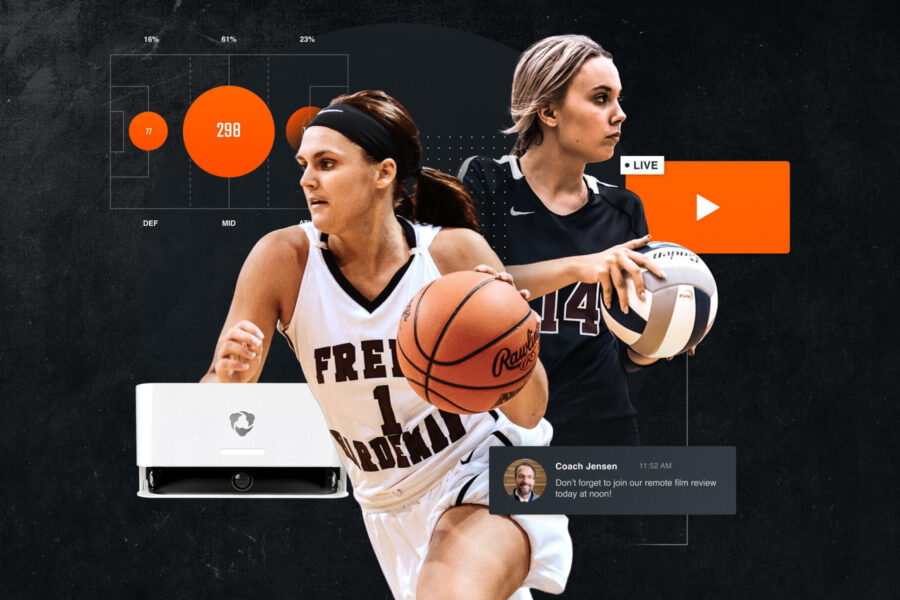Leveling the Playing Field: How Tech Can Help Women Break Through in Sports Leadership

Over the past few decades, broad access to technology and information has become a “great equalizer” for many, especially in the world of sports. While we know technology alone can't get rid of the deeply ingrained misogyny, racism and homophobia in our society, we also know it has an important role to play in the fight for equality.
To explore some of these critical topics, we teamed up with the advocacy organization WeCOACH to put on our second annual Breakthrough Summit. This was a virtual two-day event that brought together women coaches, athletic directors, commissioners, front office executives, and other leaders to discuss how tech can help drive empowerment and change.
A common theme we heard from speakers at the Summit, including college coaching legends Muffet McGraw and Dawn Staley and Los Angeles Rams scouting apprentice Mickey Grace, was the importance of allyship. Namely, how can individuals and organizations use their positions of privilege to advance inclusion in sports through intentional and conscious efforts that benefit society as a whole?
What became clear during our discussions is that although technology cannot answer this question on its own, it can be a powerful tool for driving change.
During the COVID-19 pandemic, four times as many women as men dropped out of the labor force, largely due to a lack of child care.
It’s an unfortunate reality that women in sports leadership who have children are confronted with different expectations than their male counterparts with children. A male football coach with kids might be able to spend the majority of the year traveling the country to recruit players, while a woman coach fighting for the same job might be considered a less attractive candidate due to the perception that she is tied down with childcare duties or could be unavailable to travel if she were to become pregnant.
The pandemic has created an enduring shift in the culture that requires less travel and more remote coaching and recruiting. This shift can have a disproportionately positive impact on advancement for women and primary caregivers in coaching. It enables women coaches to move from a “work-life balance” to a “work-life blend,” doing more from a distance and saving them valuable time.
These advances also benefit male leaders in sports, who have more time to spend with their families—driving home an important lesson in allyship: when women win, we all win.
We’re currently at a watershed moment for women in sports, with Kim Ng’s recent appointment as the first woman to serve as general manager of a Major League Baseball team, Sarah Fuller becoming the first woman to play in a football game for a Power Five conference team, and Lori Locust and Maral Javadifar serving as assistant defensive line coach and assistant strength and conditioning coach (respectively) for Super Bowl LV champions, the Tampa Bay Buccaneers. However much we celebrate these wins, they also underscore McGraw’s 2019 comment: “We don't have enough female role models. We don't have enough visible women leaders. We don't have enough women in power."
We don't have enough female role models. We don't have enough visible women leaders. We don't have enough women in power.
Many American sports leagues continue to be “boys clubs,” where familiar names cycle in and out to interview for leadership positions. This is a persistent issue even in women’s college sports—a higher percentage of head coaching positions were held by women in 1971 than they are now. Analytics and technology can help change that.
Analytics has, over the last 10-20 years, almost become table stakes for sports organizations, dictating everything from roster decisions and play-calling to preparation and conditioning. Mastering analytics can not only help women candidates stand out, but also serve as an unimpeachable credential. With more scrutiny on diversity in hiring decisions, simply having soft skills, such as being “likeable” or a “good leader” are increasingly insufficient without hard analytics skills to back them up.
A woman candidate for a coaching position may not have the same list of prior positions on her resume as a male counterpart, but superior skills in using performance analysis tools—which are more ubiquitous and accessible than ever—might push her over the edge and get her the job. While “old school” male coaches might be resistant, women can lean into technology and analytics as an inside track toward landing more coaching positions. Though the playing field unfortunately still tilts toward the status quo, analytics is set to grow in importance, and it will be incumbent on allies in sports technology to make sure the keys get into as many different hands as possible.
Despite significant progress since the passage of Title IX in 1972, women’s sports are still woefully underrepresented in mainstream sports media. A mere 3.2% of sports coverage is devoted to women’s sports. As a result, young women athletes rarely see themselves represented and tend to enter sports later, record lower participation, and exit earlier—and at a higher rate—than men.
Though the sports technology industry can’t force mainstream media to cover more women’s sports, we can certainly use our platform to help empower young women athletes, who are the next generation of women’s sports leaders. Technology has made it easier than ever for athletes to get exposure, with more youth sports being streamed live and the ability to share personal highlight reels with the world without having to rely on approval from traditional channels. And thanks to social media, young women athletes are able to find like-minded and supportive communities that encourage them to stay in the game and pass the torch to the next generation of young women.
Furthermore, there’s more content generation than ever for young amateur athletes—and not just TikTok. They can now watch game video of themselves and more easily analyze their own performance. This doesn’t just drive a deeper understanding and passion for their sport, but allows them to see the game from the angle of a coach. More access to this kind of content and technology for women youth athletes can help create a pipeline for the next generation of coaches.
In a recent article for the Harvard Business Review, David Smith and W. Brad Johnson stated something that should be obvious but bears repeating: “A humble and curious question goes a long way toward building better empathy and situational awareness.” Specifically, they asked men to acknowledge that there’s a lot they don’t understand and can’t possibly fathom about what women experience daily.
Asking, listening, synthesizing, and understanding – these were the goals of our Summit, but they are also things that need to happen on a broader institutional, organizational, and individual level to advance equality. As sports technology and analytics companies continue to build groundbreaking solutions that make leaders’ jobs easier, they shouldn’t lose sight of how their actions and their solutions can advance women and other underrepresented communities.
